-
Projected Light
Posted on November 22nd, 2009 No commentsFig.1 shows the overlapping light beams as shown in most books on physics to try to convince the public that white light is composed of all the other colours.
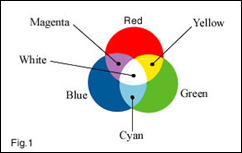
Unfortunately the illustration does not show the actuality, because there are no neat uniform areas of colours as shown. The light projectors do not project an even circle of colour as shown because the high intensity white beam always shows through the filters.
Consider the following extract: ‘It is an advantage if the projectors are controlled by rheostats, so that the relative intensities can be controlled in order to produce a good white’. From PHYSICS – An Examination Course. By E. L. Hansen. Hulton Educational Publications Ltd. In other words, if the physicists cannot obtain the results that they want, they are allowed to cheat. To be fair they don’t understand that it is cheating.
If you look at a Blue filter lying on a white sheet you see an even blue shade across the whole filter. If you shine a light through any filter you get results similar to those shown below.
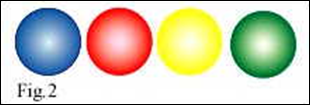
It is obvious that a considerable amount of white light is coming through the filters. If we re-label the above drawing to allow for this white light we arrive at the following drawing.

In the above drawing we are looking at the combined colour energy levels in particular areas. We are also getting dangerously close (If you are a physicist) to the artists colour mixing principles.
In the ‘Yellow’ area the combination of colours would give a yellow ochre. In the ‘White’ area the combination would give a very light grey. The white intensity from the lamps is very much higher than the white intensity from a ‘White’ screen, and therefore a relatively small amount of white light has a far greater impact than you would expect. Referring back to the chapter on the energy value of coloured light, the white light from the lamps has a probable intensity of at least 10 times greater the yellow light from the filters.
See ‘The Origin of Colour’, Taper Slit experiment, Taper Silhouette Experiment.
Technorati Tags: Projected Light,Colour,Colour – New Experiments,First published November 22nd 2009 -
Colour – Williams’ Taper Silhouette Experiment
Posted on November 22nd, 2009 No comments.
For our second experiment we use a tapered silhouette as shown.

If you view this silhouette through a prism you will see a spectrum as shown below.

In the above view the Blue and Red bands are forced into occupying the same space, therefore the combined energy plus some turbulence gives us Magenta. Where you would expect Green i.e. where the Blue and Yellow bands cross, you have the extra energy of the Red light in the Magenta which is being squeezed into the same area. This forces the total energy back into White. This I refer to as a ‘compression spectrum’.
It should be remembered that in the slit experiment the light can expand into the dark area. In the silhouette the colour bands are under pressure from the surrounding White light. Regarding the hypothesis that Yellow light is a combination of Red light and Green light, there is no evidence of any Green light. If there was a Green band between the Yellow band and the surrounding White I might have been interested in the hypothesis.
Note: Light acts in exactly the same way as any fluid, and follows the laws of fluid dynamics.
Abstract from Physics or Fantasy – Section 2 – Colour and the Quantum Theory
See also Williams’ Taper Slit experiment
-
Colour – Williams’ Taper Slit Experiment
Posted on November 8th, 2009 No commentsTo demonstrate that Green and Magenta are not ‘Primary’ colours, the following simple experiments are presented. For the 1st experiment, we have a tapered slit in place of the normal parallel slit.

If you view this slit through a prism you will see a spectrum as shown below: –

- As the Yellow and Cyan (Bright Blue) bands overlap the result is Bright Green.
- As the Red and Blue bands overlap the result is Purple.
- As the Yellow and Blue bands overlap the result is a Mid Green.
- As the Cyan and Red bands overlap the result is Mauve (Light Purple).
These are exactly the same as the artist’s mixing rules.
The physicist’s distorted ‘Standard’ spectrum forces them to argue that a completely different set of physics laws must apply to light.
Notes
- At the thin end of the slit the amount of light passing through is drastically reduced and makes it difficult to accurately determine the colours.
- The Cyan band is caused by the interference effect between White and ‘true’ Blue.
You will notice that there is no Magenta involved. Magenta requires a certain amount of compression to create the additional energy and should not be confused with the Mauves and Purples.
The Slit and Taper Slit spectra are what I call ‘Expansion Spectra’.
Short extract from Physics or Fantasy – Section 2 – Colour and the Quantum Theory.
-
Colour and the Prism
Posted on October 26th, 2009 No commentsWe are taught at school that a prism splits White light into its component colours. This is not true. Pass White light through a prism and you get White light. You cannot see a spectrum through a prism unless there is an edge visible. It is the edge that creates the colours, by reducing the energy of the light passing the edge, in the same way that water passing through an orifice has a reduced flow-rate adjacent to the edge of the orifice.
“Grimaldi has inform’d us, that if a beam of the Sun’s light is be let into a dark room through a very small hole, the…, and that these shadows have three parallel Fringes, Bands or Ranks of colour’d Light adjacent to them.”
From Sir Isaac Newton’s ‘The Third Book of Opticks’, fourth edition, first paragraph, originally published 1730, Dover Publications, Inc, New York. Standard Book Number: 486-60205-2
It is clear therefore that the creation of colours by an edge has been known to science for nearly 300 years. However I have never seen any mention of this in any modern book on physics.
This discovery by Grimaldi – Italian physicist – (1618-1663) was quite important, but its main significance was missed by the physics establishment, (Possibly not true of Newton, because he was quite devious in many ways, and his inclusion of the above paragraph as the introduction to Book Three would indicate that it had particular importance to him.)
It is also obvious from the above that the edge creates THREE colour bands, not 6 or 10 or 20 or 50. These bands are the Dark Blue, Red and Yellow referred to in this web site. from which all other colours are derived. Although you can understand it being missed 300 years ago, there is no excuse in modern times for this evidence being ignored. The problem was (and still is), that it had already been accepted by the physics establishment that White light was a combination of all the other colours.These coloured edges are commonly visible when looking through windows at a bright sky. The window is a wide slit. The shadows on both sides of a beam of light coming through a slit have coloured edges. We should really say that the White light passing through the slit has differently coloured edges.
A prism does not split White light into the different colours. but makes the colours created by the edges of a slit more readily discernible. If the slit becomes too narrow the coloured edges meet and give the distorted and blurred spectrum that physicists claim as a ‘true spectrum’.
See also Taper Slit Experiment, Taper Silhouette ExperimentFirst Published October 26th 2009 -
Colour Filters- The Mechanics.
Posted on October 26th, 2009 No commentsPhysicists have never grasped the mechanics of colour or colour filters.
Most books on physics claim that Yellow is not a primary colour and that it is a combination of Green and Red light. This is based on the fact that both Yellow and Blue light will pass through a Green Filter. They say that Blue does not pass through a Red filter, which is untrue. They also claim that Red will not pass through a Blue filter, which is also untrue. In fact the filters reduce the energy of any light passing through them. White light passing through a Yellow filter will have its energy reduced into the Yellow range. The Red filter reduces the light into the Red range, and the Blue filter further reduces the light into the Blue range. The Yellow light exiting the Yellow filter carries some White light, the Red light exiting the Red filter carries some Yellow light and the Blue light exiting the Blue filter carries some Red light. The lower the energy of the light the easier it passes through a filter. White light passing through a Blue filter always gives you Blue plus White.
In the sketch below the Blue light passes through the yellow filter easily but the residual White from the Blue filter picks up some Yellow light, therefore creating a Dark Green. The higher energy Yellow is mostly reduced to Red while passing through the Red filter, leaving the lower energy Blue to pass through without difficulty.
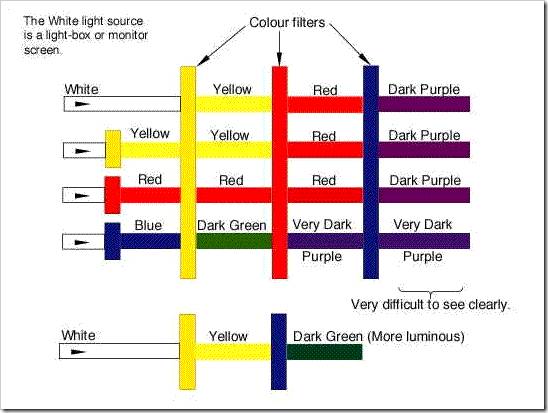
Colour filters are not really filters they are optical resistances. They reduce the energy of light passing through them, they do not filter anything out of the light. A light beam loses energy by reflection and heat. A beam of White light striking the surface of a filter reflects a considerable amount of White light. The darker the filter, the greater the energy lost to reflection. A Dark Blue filter reflects almost White light, a Red filter reflects a bright Rose Pink, and a Yellow filter reflects a distinct Yellow. Energy is lost in the heating up of the filter itself, again the darker the colour the greater the heat loss.
Note: None of the ‘standard’ colours of pigments, or the RGB, CYMK, etc of monitors can produce the actual ‘true’ primary colours. The colours in the above drawing are only approximate. The closest are Red, Navy, and a slightly deeper version of the Yellow. With the addition of White and Black all other colours can be produced from these. See ‘Origin of Colour’
The colour of light passing through a filter depends on various conditions. It depends on the intensity of the light source and the colour of the light source. The simple experiment below demonstrates the type of logic error common in physics research. The left hand sketch shows white light reflected from a White card and then passing through a Red filter. Most people consider that if they lay a Red filter on a white board then the White light from the board shines through the filter in the same way as the left hand sketch. This is not true, because the light passing through the filter from the board is Red, not White, as indicated in the right hand sketch.
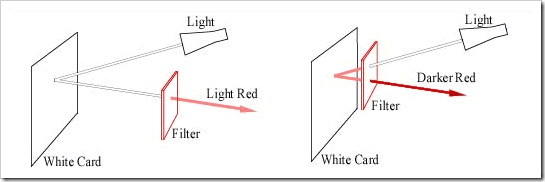
Why can a lower energy colour such as Blue pass easily through Red and Yellow filters, yet higher energy colours like Red and Yellow have difficulty passing through a Blue filter? The answer is simple mechanics.
The light passing through a filter may be compared with well-protected dodgem cars travelling along a wide highway that is scattered with large concrete blocks. The cars travelling at low speed will be able to negotiate these obstacles without mishap, and without much loss of speed. If the speed increases there will be collisions with the obstacles or other cars. The greater the speed, the greater the chance of collisions occurring. Comparing with light filters, the Blue filter would have many concrete blocks; Red would have less and Yellow even fewer.
It is obvious that the lower speed cars would have no difficulty passing through areas with fewer concrete blocks. This means that the cars (Particles) having the least energy have the least difficulty in passing through the obstacle course (Filter).
The interactions between cars (Particles) would be considerable, collisions causing some cars to accelerate and others to be slowed down, and some to be deflected off the side of the road (Heat emission). Some of the higher speed cars could pass through the area with little loss of speed, slight collisions with other cars deflecting them away from concrete blocks.
While on the subject of filters let us look at some others aspects of the physicists hypotheses on colour. Consider the arguments that White light is composed of all the other colours. This is on the basis that all other colours can be obtained from White light. This is a very weak hypothesis. If you have a 120 volt power supply you can obtain 100v, 24v, 12v, 6v, 3v or 1.5v from it. This does not mean that a 120 volt power supply is made up of all the lesser voltages.
As already shown you can obtain Red, Blue and Green light from Yellow light. This does not mean that Yellow light is made from Red, Blue and Green light.
The physicists statements that Blue light has the greatest energy is based on the illogical argument that “in a deep filter only Blue light passes through it and this proves that Blue light must have more energy.” Obviously they are forced to this conclusion by their conviction that White light is a combination of all the other colours. Using the same type of “logic” they could claim that as the water coming from the end of a 10km long x 25mm diameter. pipeline is only at a very low pressure, then this proves that only very low pressure water has the energy to travel this far!
Green Filters.
There are a lot of hits on the subject of Green filters. White light passing through a Green (mixed pigments of Yellow and Blue.) filter, results in a mixture of White, Yellow, Blue and normally a small amount of Red. (See Projected Light). The Red comes from a small amount of the Yellow light losing enough energy to fall into the Red range.
The colour seen through a filter depends on the make-up of the particular filter. If a green filter is a mixture of 10% Yellow and 90% Blue pigments, then approx. 10% of Yellow light will pass through. However, if the filter is 90% Yellow and 10% Blue then the light will probably contain a larger proportion of Red. The Yellow pigments will allow Yellow, Red and Blue light to pass through, the Blue pigments will only allow Blue light through, (With a touch of Red). This problem applies to all colour filters. A Royal Blue pigment is a mixture of Blue and Red pigments. Only by determining the basic ‘True Colours” can we create a scientific basis for colour, and form a common standard based on the actual physics of colour.
When considering colour filter set-ups it is essential to look at the mechanics of the system.
Consider where White light passes through a Red filter, reflects off a Green coloured board, and the board is viewed through the Red filter. The physicists argue that the Green is seen as Black through the Red filter. This is not so.
Green is a mixture ‘true’ Blue, (a very dark Blue), and ‘true’ Yellow, the actual shade depending on the relative proportions. The residual White light (See Projected Light) is reflected off the Green board as a mixture of ‘true’ Blue and ‘true’ Yellow light, and the Red light exiting the filter will be reflected off the Yellow pigment as Red and off the Blue pigment as Blue.. The Blue, on the second pass, will easily go through the Red filter but the Yellow light is mainly reduced into the Red range. We are therefore looking at a very dark Purple colour, which, under normal viewing conditions is easily mistaken for Black.
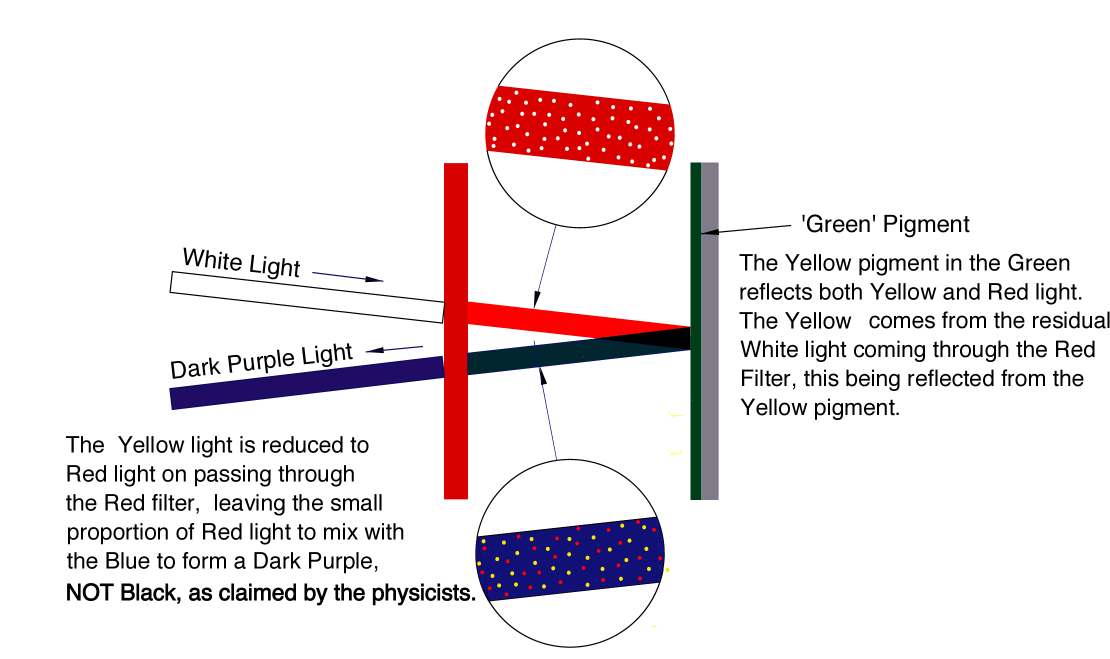
Reflected Green Light
If the Green is a light Green, this may because it has a greater proportion of Yellow pigment, or because it has a percentage of White pigment included. In this situation the Green board will appear to be a lighter purple.
A bit complicated, but mechanics is complicated, the main reason physicists can’t understand it.
Author, Brian Williams
GO TO “Master Page – Index” for related Colour posts that will help you to understand colour.
Technorati Tags: Colour Filters -
Newton’s Colour Wheel – The Reality
Posted on October 26th, 2009 No commentsModern physics considers that Newton’s rotating disc experiment proves that White light is composed of a combination of colours. The original experiment consisted of a rotating disc painted with various coloured sectors. As the speed increases the colours blur and become a greyish colour. The argument that this proves that White light is composed of the different colours is totally untrue. Most paints and dyes include white pigments to obtain the lighter shades. As the disc rotates the reflected light is a mixture of Blue, Red, Yellow and White light
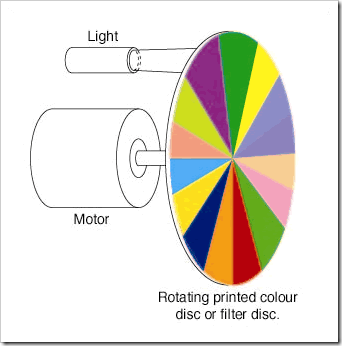
The predominant pigment seen is White and this is seen for most of each rotation of the wheel. If 10 of the 15 sectors contain White pigment then White light will be seen for 2/3rds of each revolution.
If there are Red pigments in 5 of the 15 sectors then Red light will be seen for 1/3rd of each revolution. Similarly for Blue and Yellow pigments.
Also of importance is the relative energy of the reflected light. The White light has considerably more energy than the other colours and will therefore have a greater affect than just its relative proportion. Yellow will have a greater affect than Red or Blue, etc..
If we use a filter disc and shine a White light through it, we have a similar situation. Most filters allow some white light through them. In general therefore we will see White light for 100% of each revolution of the wheel. The points in the previous paragraphs also then apply.
The actual shades and percentages of pigmentation will determine the shade of ‘Grey’ seen.
If we had 25% each of Blue, Red, Yellow and White pigments, then the reflective energy of the 25% White would probably be greater than the combined energies of the other colours.
Note that what if we look at a sheet of ‘White’ paper whilst inside a well lit room, it reflects only about 10% of the energy that it would if viewed outside on an overcast day. It still appears to be White in both locations.
The retinal cones are also confused by the constant colour changes above 16 changes per second. The relative constancy of the White during each revolution allows the cones to easily identify White.
Although normally used to ‘obtain’ varying shades of Gray, the colour wheel can be used to produce any colour by using only White, Yellow, Red, Dark Blue and Black sectors in varying proportions.
If the wheel only has Yellow and Blue pigment sectors or filters the colour seen is Green, therefore ‘proving’ that Green light is composed of Yellow and Blue light. If you only use Red and Green on the wheel you get Gray/Khaki, not Yellow as argued by the physicists. This is using the same principles/hypotheses as the physics establishment.
However, if you force (Yellow + Blue) = Green + Red into the same space the total energy (Speed) increases into the Yellow range or even sometimes into White. Basic Fluid mechanics.
Author.-Brian Williams
See An Introduction to Colour for further information.
See also Projected Light , Colour and the Prism andTechnorati Tags: Newton’s Colour Wheel -
The Origin of Colour – New Research
Posted on July 3rd, 2009 No commentsThe retinal cones can differentiate 4 different energy/velocity ranges which the brain interprets as the colours Blue, Red, Yellow and White. Light ‘particles’ entering the cone and having sufficient energy to pass through to the 4th compartment are assessed by the brain to be ‘White’ light. Any light passing into the 1st compartment but without sufficient energy to pass into the second will be assessed as ‘Blue’ light. Similarly with the ‘Red” and ‘Yellow’ compartments.
 Although this may appear to be too simple to explain the wide range of colours and shades, in fact it explains all of them. It also provides the explanation of ‘Colour Blindness’, which I considered essential to any theory of colour. Yes I am aware that the above simplified version of the retinal cone is very little like a real retinal cone. The real cone is a very messy looking unit that could do with a bit of engineering updating, but it does do what it was designed to do. Although the shapes and sizes of individual cones may widely vary, the human brain can adjust the information in the same way that a good pianist can play a badly tuned piano.
Although this may appear to be too simple to explain the wide range of colours and shades, in fact it explains all of them. It also provides the explanation of ‘Colour Blindness’, which I considered essential to any theory of colour. Yes I am aware that the above simplified version of the retinal cone is very little like a real retinal cone. The real cone is a very messy looking unit that could do with a bit of engineering updating, but it does do what it was designed to do. Although the shapes and sizes of individual cones may widely vary, the human brain can adjust the information in the same way that a good pianist can play a badly tuned piano.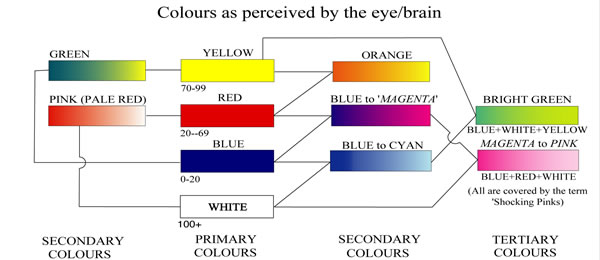
Colours as Perceived by the Eye and Brain
The addition of two colours of different energy levels creates turbulence in the ‘cones’. Where Blue and White are mixed as in Cyan, Bright Green and Magenta Pinks, this creates the greatest turbulence which is irritating to the eye. Lesser energy differentials such as Yellow and Blue (as in the natural Greens) give a more gentle turbulence which is soothing to the eye. It should be realised that the ‘True’ Primary colours actually cover a range of energy levels, i.e. in the ‘true’ Red above the range is shown as 20-69 (hypothetical energy units). This means that light having energy in this range will be perceived as ‘true’ Red. Colour ‘Blindness’ is due to either chemical differences in the cone fluid altering the resistance to the passage of light and therefore changing the section of the cone into which it finally arrives, or may be due to actual physical differences in the cones. The effect of the actual energy level will only become apparent when combined/mixed with other Primary colours. It should be realised that the ‘Wave Hypothesis of Light’ is unable to explain any of the colour phenomena, because the mixing or combining of colours would destroy any ‘frequency’ involved in light. There is also the fact that the eye is confused by frequencies above 15-20 cycles/sec, yet the physicists argue that the eye operates at approx 10,000,000,000,000,000 cycles/sec. See also Newton’s Colour Wheel, Taper Slit Experiment, Taper Silhouette Experiment. First published July 3rd 2009
Brian Williams – Author
-
Basic Principles of Research
Posted on June 26th, 2009 No commentsPhysics is the knowledge of how things work in the universe. This includes both non-biological and biological knowledge. Our knowledge is obtained through our 5 basic senses, plus extensions to these senses such as telescopes, microscopes, stethoscopes etc. The information from the senses is then passed through to our brain to work out what it all means. Therefore all research depends on our senses.
Eyes Seeing Ears Sound Nose Smell (Chemical Analysis) Tongue Taste (Chemical Analysis) Skin Touch(Pressure), Temperature The most highly developed of our senses is seeing. Physicists often refer to the unseen world of the atom, yet the brain depends on the eyes ability to detect particles much smaller than the atom, i.e. sub-atomic particles, to give us our sense of sight.
Smell and Taste can differentiate atoms and molecules, in some people to a very high degree of accuracy. Many people operating within the chemical industry can accurately determine some chemicals by taste to within 1 part per million. Many creatures can do far better than this, being able to detect 1 part in many billions. The dog can detect dispersed scents (Smell) after many hours and over many miles, and the shark can detect blood components (Taste) from many miles away.
Research
There is a normal method of carrying out research which is based on experience and common sense.
- Accumulation of information.
- Analysis of information.
- Deduction.
In modern physics step 2 is almost always ignored, and has been replaced by the application of mathematics. The most well known by the public of all modern physics subjects is Einstein’s e = mc2, the deduction from the information accumulated from the Michelson-Morley experiments. The experiments were straight mechanics problems, with the results obtained deducible without the use of any mathematics. Unfortunately the physicists do not understand mechanics, and even applied the wrong trigonometric formulae.
Consider this extract, proudly proclaiming the great strides in physics.
“Firstly, the abandonment of the ideal of a mechanical explanation of everything has eliminated a great deal of idle hypotheses. The properties of the fundamental entities of physics are now stated in the form of mathematical equations, instead of being ‘explained’ by a hypothetical mechanism.” From ” The Philosophy of Physical Science”, by Sir Arthur Eddington. This is the ‘Eddington’ usually quoted by physicists when they are asked awkward questions.
It is clear from the above passage that not only do physicists not understand mechanics, part of their catechism is that mechanics should actively be ignored in favour of mathematics.
Note, I have been involved in mechanics all my life, but I have never come across a ‘hypothetical mechanism’. As an engineer I only deal with reality, and the main role of engineers is to understand how things work. Analysis is the mental process that the human brain uses to arrive at an understanding of any problem. Whether you are considering crossing a busy road, deciding what to have for dinner, considering the best way to operate on an injured patient or how to find your way home when you are lost, are all examples of analysis. Mathematics is never involved. Analysis is based on our knowledge (accumulation of information) and the relationship between individual bits of this information.
Modern physics now operates on the ‘Black Box’ principle. If you have something going into a black box and something else coming out, it is extremely easy to find or construct a formula to match the in-goings and outgoings. However, no formula will ever tell you how the black box works, or is constructed. You need an in-depth knowledge of mechanics to do this, even if dealing in biology, chemistry or physics.
The analysis of information must include the following:
- Is all the information pertinent?
- Does any apparatus used have any effect on the information (a crucial area for serious errors)?
As a child of 5 or 6 years, I was in possession of 2 items of crucial scientific importance, and also a fine laboratory. The fine laboratory was a cinder covered field directly in front of our house. that was half full of garages. This field sloped, and in rainy weather, the rain gouged little rivers and created ponds that fascinated us children. If any physicists had ventured into our laboratory and asked us how waves are created all of us would have given the same answer, which was “By the pebbles we dropped into the ponds, and by the sticks we poked into the streams“, the two items of crucial scientific importance that I refer to. The pebbles and sticks are items of apparatus that seriously affect our observations, just as the prism and lens affect our optical experiments.Even as children, although we believed in fairies, Father Christmas, and ghosts, we would not have been gullible enough to accept the argument that by dropping a pebble into a pond we were magically seeing the wavelike nature of the still water, or magically seeing the wavelike nature of a steady flow of water, as seen when putting a stick (Magic Wand?) into it.Modern physics is full of people who demonstrate a naivety far greater than most 5 or 6 year old’s. The implications of the above 2 simple (childlike) experiments require an understanding and knowledge of mechanics that modern physicists just do not have.Physicists still do not understood that their ‘evidence’ for the Wave Theory of Light’ is entirely an illusion created by their apparatus, in a similar manner as our childhood playing with water. The waves created in water by the apparatus do not prove that water itself has a waveform or frequency. The waves created by the apparatus in optical experiments do not prove that light itself has a waveform or frequency.If the number of people entering a store was plotted against time, the plot could show a sinusoidal waveform. This would not prove (at least to me) that the individual people had a waveform or a frequency.See Physics or Fantasy – Section 1 – Light and Relativity.Brian Williams – Author
-
Einstein’s Wrong Formulae
Posted on June 26th, 2009 No commentsDo you know the important differences between these formulae?

t1 = [d/(c + v)] + [d/(c – v) ] A1 t1 = [d1/(c + v )] + [d2/(c – v)] A2 t2 = 2d/(c2 – v2)0.5 B1 t2 = (d1 + d2)/(c2 + v2)0.5 B2 Formulae A1 and B1 are the ones used by physicists to ‘prove’ the constant speed of light on the assumption that they are in accordance with classical mechanics. These are the formulae given in physics books. Unfortunately, they are both “special case” formulae which are quite specifically not applicable to the Michelson – Morley experiment on which Einstein’s Relativity is based.
Formulae A2 and B2 are the ones that are correct in accordance with classical mechanics. Although the differences appear minor, Einstein’s Relativity, The Constant Speed of Light, Time Dilation, E = mc2 etc. are all based on the formulae A1 and B1.
More importantly, the above formulae are only 25% of the mathematics needed to solve the problem of the Michelson-Morley experiment. The other 75% is not even considered by Einstein and the rest of the physics establishment
Einstein, not understanding mechanics, did not realise the implications of this error of Michelson and Morley and carried the same error into his own calculations.
If the correct formulae are used i.e. A2 and B2, plus the omitted 75% , all the above hypotheses become extinct, and light is proved to strictly follow the principles of classical mechanics.
Does it matter? Yes, the use of the wrong formulae has cost the people of the UK billions of pounds, and is still costing many millions of pounds every year.
Physics or Fantasy – Section 1 details the errors in full and shows that the mathematics relating to the time of transit for the beams of light in the Michelson – Morley experiment are more complex than realised by the physicists.
Brian Williams – Author

